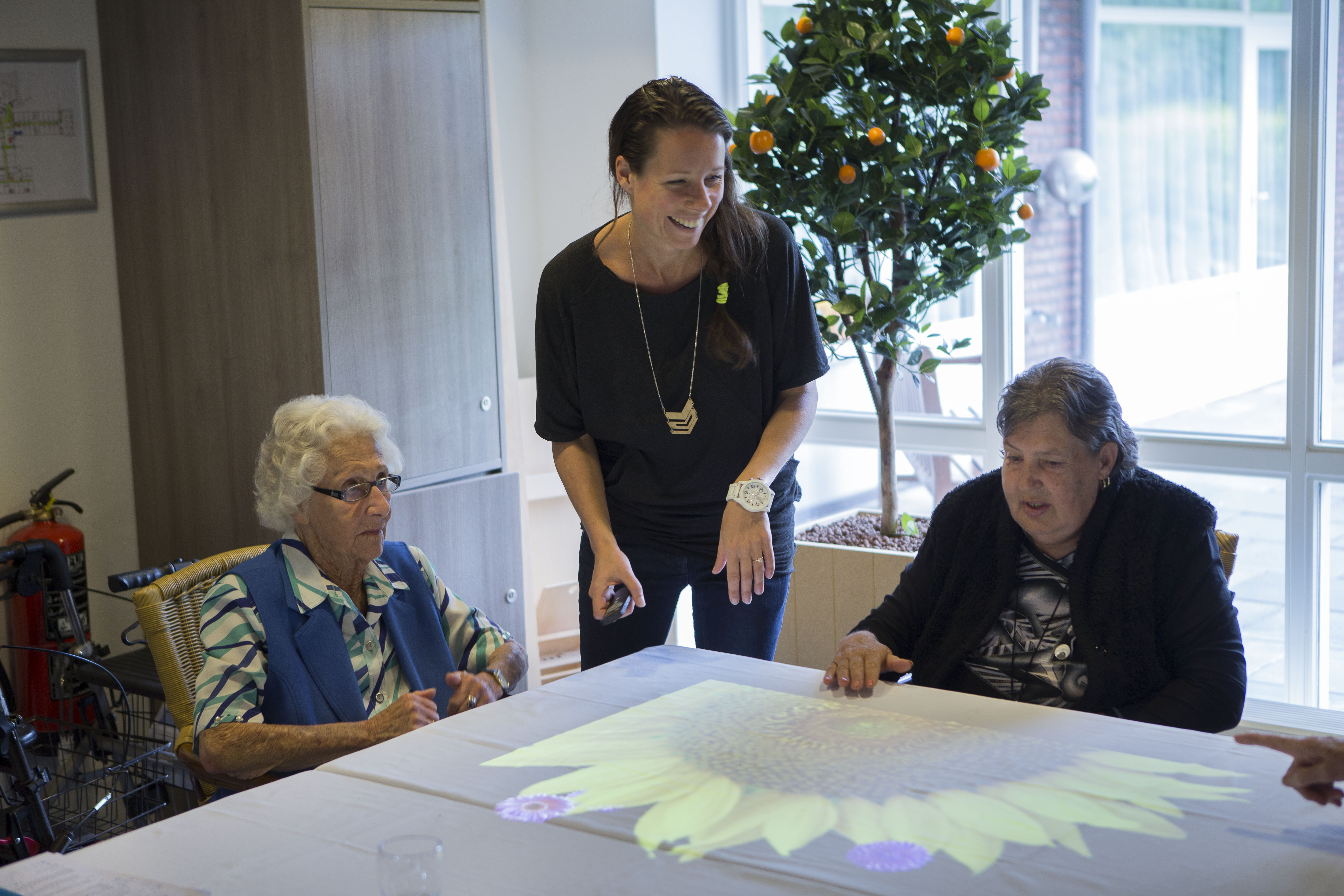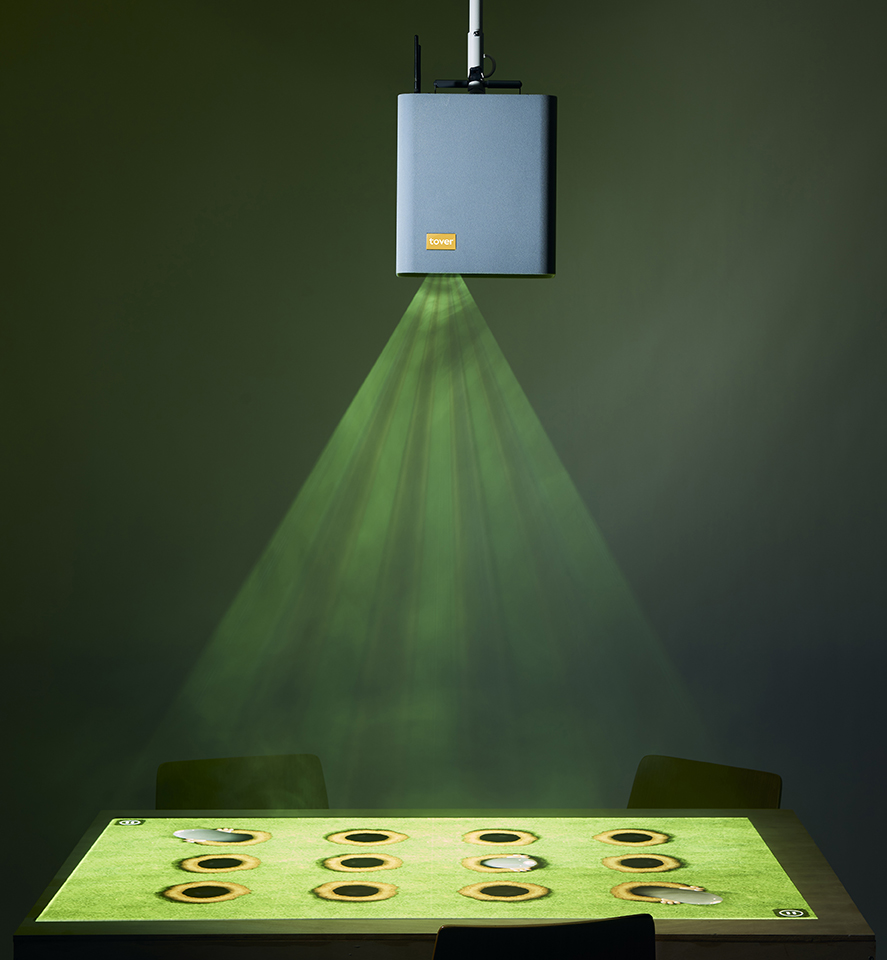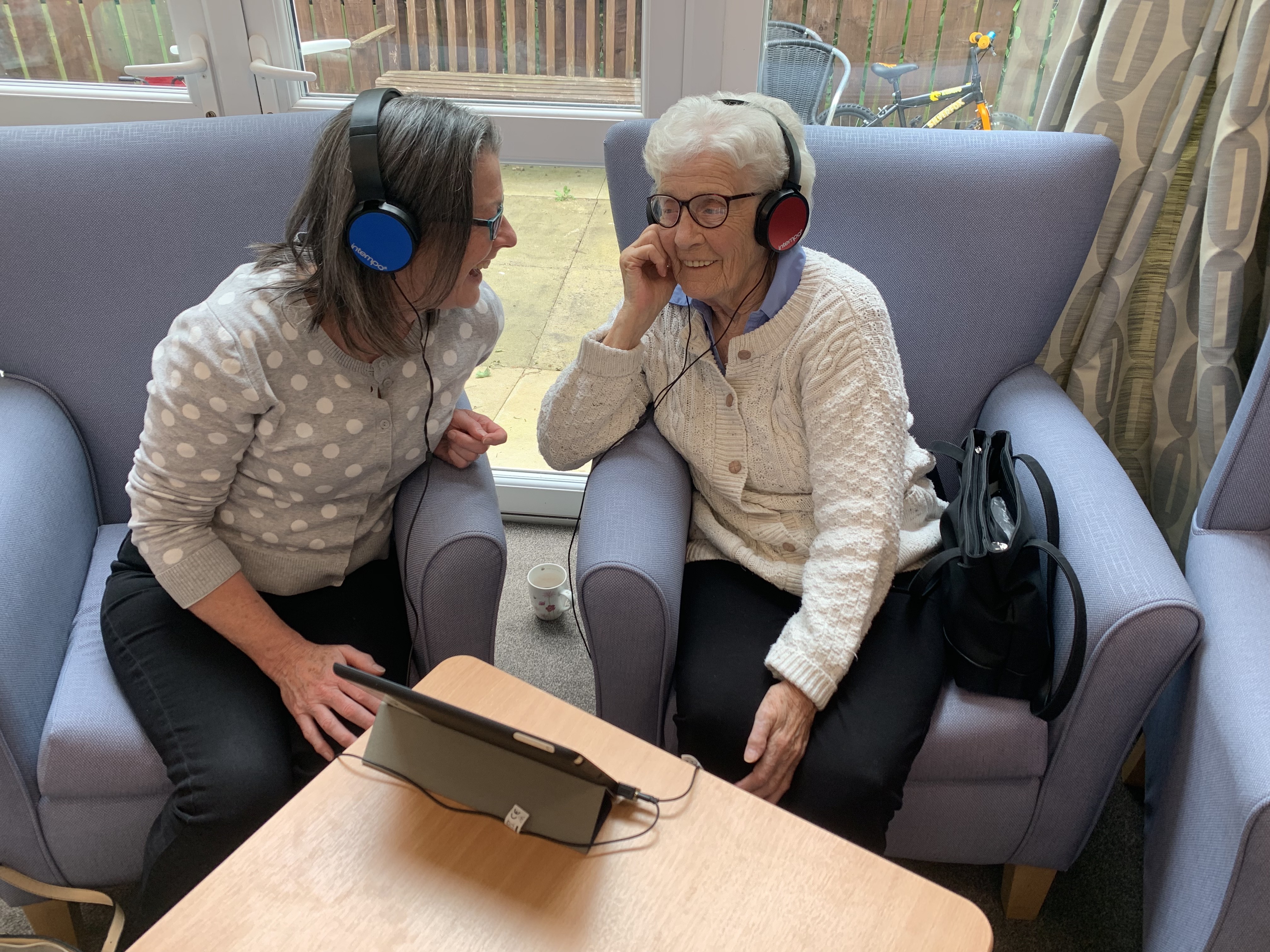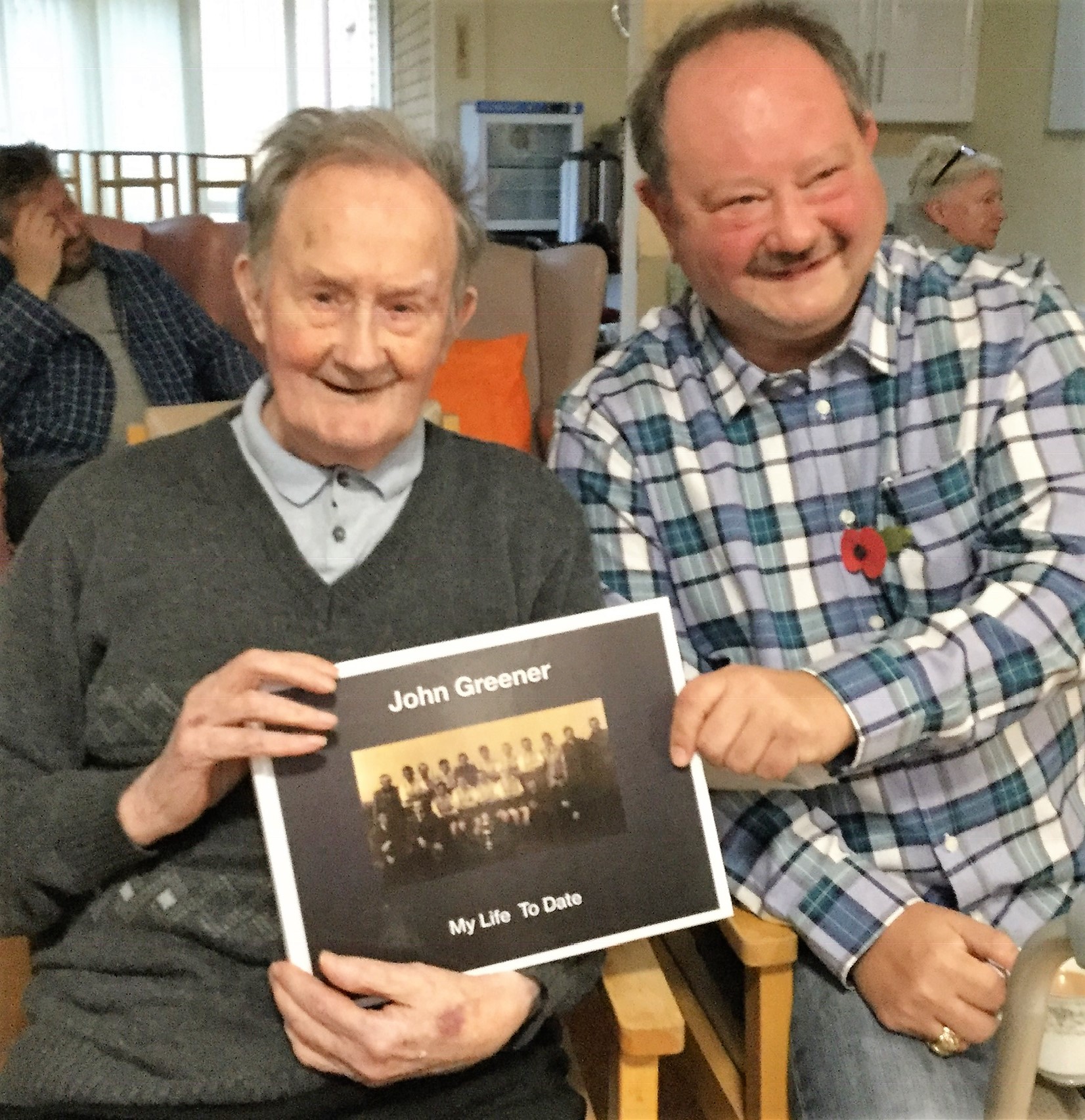How tech innovation can support people with dementia
Sarah Botterill | 26 May 2021How can technology help people live with dementia? AbilityNet discovered three innovative projects that support people through technology solutions on a recent webinar.
Uniting them is the joy each brings to individuals and those who care for them.
We heard from:
- Tover: how the Tovertafel is helping in care homes
- Digital Voice: how capturing stories is helping people with dementia
- Luminate: How Scotland’s creative ageing organisation is stimulating people living with dementia
Tovertafel, a playful approach for professionals
 The Tovertafel or “magic table” is the brainchild of Tover, and we were delighted when Tover's CEO and founder Hester Le Riche joined our webinar.
The Tovertafel or “magic table” is the brainchild of Tover, and we were delighted when Tover's CEO and founder Hester Le Riche joined our webinar.
The spark ignited when Le Riche was studying for her PhD in 2009 while she was involved in professional sports.
“Two parts of my life crossed when a professor explained to me how important it is for people living with dementia to be active,” she told webinar attendees.
Le Riche added: “Apathy is the biggest hurdle for people and loneliness and depression. Your brain deteriorates faster by sitting still most of the day.”
An engineer by background, Le Riche set out to co-design and develop a product that would stimulate physical activity in people living with dementia.
Ultimately, this became Tovertafel and created Tover, which now has 75 employees.
What is the Tovertafel?
 The Tovertafel is a ceiling-based projector that shines lights onto an existing surface – usually a table. People can sit at the table and play with the lights.
The Tovertafel is a ceiling-based projector that shines lights onto an existing surface – usually a table. People can sit at the table and play with the lights.
Lights are interactive and respond to movement and touch.
There are many "games" that come with Tovertafel.
Tovertafel games include everything from one that enables people to decorate a birthday cake to one where people can wipe swirling leaves off the table complete with rustling sounds.
“Our interactive games have several goals. We engage physically and invoke many connections and talk about the past, and we also stimulate the brain and emotions, everything to reduce apathy,” said Le Riche.
It is designed for use within care home settings.
“The Tovertafel is a playful innovation, and the sole goal is to improve the quality of life or resident and carers and family members, we use senses to detect the hand movements and based on those movements we make projections,” said Le Riche.
“We're busy in Sweden and Germany and the States, the Netherlands and France – as well as the U.K.," Le Riche added.
The Tovertafel costs £6,760 (exc. VAT) for the device and for a two-year Open Play and Learn subscription. You can book a demonstration online via Tover.
Lessons from co-designing the Tovertafel
Tover designs the Tovertafel with, as well as for people living with dementia. This co-design principle is a critical element of the company's ethos.
In designing the Tovertafel, Le Riche conducted extensive research. She explored how the physical environment impacts people living with dementia, the footprint of a care home, and the lighting and the wall colours.
She also conducted qualitative research on the social environment and how it impacts people's alertness or ability, or motivation to do something.
“What was the most impactful on me is that there was so little interaction between several residents that I had observed and interviewed,” said Le Riche.
She added: “I thought ‘you are there and in the same boat’. And you have so much time to collaborate or have a chat or do an activity together, but there were so many barriers to do so.”
Le Riche also conducted a literature review.
The most critical insights from observing people.
“Doing the PhD, I took as a case the activity of drinking coffee. So, if we can help to be more independent, I had a cup of coffee, and I was projecting my light around it; maybe I can bring attention to the cup, so I just thought I would write it down. ‘Are you thirsty? Yeah, take another sip, nothing happened’”, Le Riche said.
“There was a moment that a lady, she put the cup away and started playing with moving lights so. I lost my faith in myself as a designer and thoughts the PhD was going nowhere. Still, I realised the goal was to design something to stimulate physical activity, and that's when I changed the concept into supporting the activity of daily living, and that's when we started to design serious games,” she added.
Digital Voice: storytelling for people living with dementia
 Storytelling can have a powerful impact on people living with dementia, as we heard from Julie Nicholson, Director of Digital Voice, a Tech4Good finalist in 2018.
Storytelling can have a powerful impact on people living with dementia, as we heard from Julie Nicholson, Director of Digital Voice, a Tech4Good finalist in 2018.
Set up 14 years ago, Digital Voice for Communities supports people living with dementia through DigitalMe, Digitale and LifeBooks.
DigitalMe explained Nicholson is "an award-winning programme that helps people of all ages to have an anonymous voice.”
Participants draw avatars to represent them, which are animated to share messages. It gives people a voice without them having to be in front of the camera.
“We do this as a face-to-face course that creates this fabulous digital artwork with a photographer using speech bubbles and digital stories that help to get those messages across in an even stronger way,” said Nicholson.
It has also been redeveloped to work virtually during a lockdown.
Digital Voice shares the finished avatars and videos with partner organisations.
“We have done this with people with dementia, and they enjoyed the different creative processes. Then we show it to decision-makers, and that will hopefully help improve service for older people.” Said Nicholson.
Once each person's individual film is made, Digital Voice makes a montage of the most powerful messages and invites decision-makers to hear the news.
“That's what it's all about having a creative way to get your messages across to change society,” added Nicholson.
Capturing a life’s story using technology
Digitale is a way of capturing a person's life story in an engaging way to help stimulate and preserve precious memories.
Using tablets, The Digital Voice team collate photographs into a slide show alongside other information to build a picture of someone’s story.
“A great example of this working well with people with dementia was a project a lady who had short term memory issues. When she was looking at the photos, it brought back memories of the past,” said Nicholson.
She added: “Everybody benefits from that, and we helped them to produce their slide show to illustrate their stories all about growing up in a mining village.”
LifeBooks: collective storytelling
 LifeBooks enable people to tell their stories within a group setting with the help of an iPad using photos and anecdotes and through songs and audio.
LifeBooks enable people to tell their stories within a group setting with the help of an iPad using photos and anecdotes and through songs and audio.
Developed with the Alzheimer’s Society, it offers a way to tap into emotional memories.
“We encourage people to add their favourite music into the books, and that session usually becomes a singalong,” said Nicholson.
“All of the sessions are group themes and as we go through their life in chronological order. So, childhood and family life and images of their favourite dance hall and discuss their memories together from their youth,” she added.
Digital Voice works with groups; they could be brought together by an occupational therapist, social prescribers, care homes and community groups
“They might live in the same care home, we find LifeBooks are most successful when each person has a buddy, so a family member or a member of staff who helps with the photos and writing down people's life stories into an App,” said Nicholson.
Participants also receive a hard copy book as a keepsake.
“It's just a lovely thing to keep, and the digital one has the audio if, so I know one family, even played the audio content of one lady's anecdote at her funeral,” said Nicholson.
As well as a keepsake, LifeBooks act as an aide-memoire, said Nicholson.
“If people are confused on a particular day, someone they can say, look here you are, this is you now, and that was you then. Or to help remember who family members are if they come to visit and they can't remember who they are.”
A creative approach in Scotland from Luminate
Luminate is Scotland’s creative ageing organisation, which aims to “challenge some of the negative thinking that exist around ageing,” said its director, Anne Gallacher.
Its vision is that all older people in Scotland have access to high-quality arts and creative activity.
“In Scotland, there is a drop off in people's engagement [with the arts]. As people get to their 60s and 70s, engagement drops [but] we know how positive being involved in creative activity is,” said Gallacher, speaking in AbilityNet’s FREE webinar.
While relatively small, Luminate's five staff makes a significant impact.
It embeds artists within care home settings where they have worked long-term with families, carers and staff to deliver tailored creative workshops.
There are also singing groups for people living with dementia.
“We have done much training for singing groups and leaders, and we run dementia inclusive events open to everybody,” said Gallacher.
Luminate also trains artists enabling them to work with people living with dementia.
Using technology to give access to the arts online
Technology maintained access to the arts
“It was a big shift for us, and we made it pretty quickly because, like everybody, we could see what was coming, and we were very concerned about the older people we work with and the artists we work with, whose work was stopping,” Gallacher said.
This included creating a series of 31 videos, including one film in Gaelic and another on "Cutting a rug".
The singing network moved online and now has its web page.
Luminate has led online Zoom sessions with care homes, including one in Glasgow on creative arts and crafts.
They learned that collaboration with care homes is vital and that artists need to be flexible.



